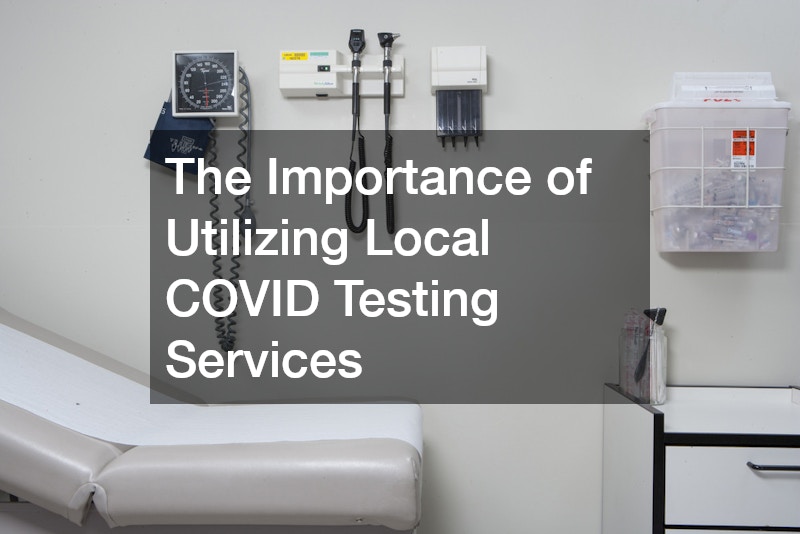This article explores the significance of using local COVID testing services in managing the pandemic effectively. By relying on localized efforts, communities can ensure more efficient management of health crises.
Why are Local COVID Testing Services Essential?
Accessibility of Testing Facilities
Local COVID testing services enhance accessibility for residents, reducing travel times and increasing convenience for testing. This is crucial in ensuring that populations, especially those in underserved areas, have access to necessary health services.
Local services eliminate the barriers faced by those with limited transportation options, making it easier to get tested promptly. Such accessibility encourages more individuals to participate in testing, thereby enhancing community safety.
With more people able to test conveniently, there’s a greater likelihood of identifying and isolating cases earlier. This contributes to a proactive approach in managing the pandemic locally.
Immediate Community Impact
Local COVID testing services have a direct impact on reducing the spread of the virus within communities. Residents using nearby testing facilities are more likely to get tested regularly, helping to identify cases sooner.
Immediate testing allows for quicker initiation of isolation protocols, thereby minimizing the chances of transmission. This local intervention is critical in breaking the chains of infection within communities.
By detecting cases early and acting swiftly, local services contribute significantly to flattening the curve at the community level. This impact is vital in safeguarding public health and reducing the burden on healthcare facilities.
How Do Local COVID Testing Services Enhance Response Times?
Faster Results Processing
Local testing facilities have the advantage of processing test results more rapidly than centralized national labs. Quick turnaround times are essential for making timely decisions on isolation and treatment.
Efficient processing helps reduce anxiety among those awaiting results, enhancing community trust in the testing system. Such trust is important for encouraging ongoing participation in testing efforts.
The presence of local laboratories is instrumental in accelerating public health responses to emerging COVID-19 cases. This capability allows communities to adapt swiftly to changing pandemic dynamics.
Efficient Contact Tracing
Local COVID testing services play a crucial role in effective contact tracing, a key strategy in controlling outbreaks. With quicker result dissemination, local services enable prompt tracing of contacts.
This timely response is vital in notifying potentially exposed individuals to take precautionary measures. Efficient contact tracing significantly curbs the potential for wider virus spread within communities.
Local involvement in testing and tracing strengthens the overall public health response, supporting containment strategies. As a result, local efforts enhance the broader national pandemic management approach.
What Are the Economic Benefits of Utilizing Local Testing?
Supporting Local Healthcare Infrastructure
Utilizing local COVID testing services can bolster local economies by supporting healthcare infrastructure and creating jobs. Local testing centers require staffing, thereby providing employment opportunities.
Moreover, these facilities stimulate the economy by ensuring money spent on healthcare services circulates within the community. This local economic activity can help communities recover from pandemic-related downturns more effectively.
Local testing points also alleviate the pressure on national healthcare resources, allowing for a more balanced distribution of healthcare support across regions. This is crucial for creating resilient local healthcare systems.
Cost-Effectiveness for Local Governments
Local COVID testing services can be more cost-effective for local governments compared to broader national strategies. By focusing resources locally, governments can reduce the logistical costs of transporting samples to distant labs.
Cost savings can be redirected to other essential health and community services, enhancing overall public health infrastructure. Efficient local testing can thus reduce both short-term and long-term pandemic-related costs.
Moreover, localized systems can mitigate the risk of testing backlogs that result in costly public health delays. Effective resource allocation ensures that local governments can maintain robust pandemic response capabilities.
How Can Local Testing Services Improve Public Health Outcomes?
Early Detection and Prevention
Local testing services are pivotal in enabling early detection and prevention of COVID-19 within communities. Rapid identification of cases allows for immediate intervention, limiting further spread.
The fact that many cases remain asymptomatic underscores the importance of local testing for early detection. By identifying these cases early, testing services can prevent more extensive outbreaks.
This proactive approach is essential in minimizing morbidity and mortality associated with COVID-19. Early detection supports public health objectives by maintaining lower infection rates.
Monitoring and Managing Variants
Local COVID testing plays a critical role in the detection and monitoring of new virus variants. These services enable swift identification of mutations, facilitating necessary public health adjustments.
As variants can lead to changes in transmission patterns and vaccine effectiveness, timely detection is crucial. Local services help provide the necessary data to inform public health strategies concerning variants.
Effective monitoring supports global efforts to understand and combat the evolving nature of COVID-19. Local testing thus becomes an integral component of a comprehensive pandemic response strategy.
What Are the Challenges Facing Local COVID Testing Services?
Resource and Staffing Limitations
Despite their importance, local COVID testing services face challenges such as limited resources and staffing shortages. These limitations can hinder the scalability and reliability of testing operations.
Insufficient staffing can lead to delays in testing and result delivery, reducing the effectiveness of public health interventions. It is crucial to address these systemic issues to ensure robust local testing capabilities.
Investments in training and recruitment are needed to build sustainable local testing infrastructures. Strengthening these resources can enhance the resilience of local health responses.
Logistical and Infrastructure Hurdles
Logistical challenges, including maintaining infrastructure and supply chains for testing kits, are prevalent in local testing services. Disruptions can result in shortages, impacting the availability of testing.
Infrastructure issues can also hinder the integration of testing data with broader public health databases. This can limit the effectiveness of coordinated health response efforts.
Addressing these hurdles requires coordinated efforts between local and national authorities to ensure seamless testing operations. By overcoming these obstacles, local testing can remain a critical element in pandemic management.
.


